

Compendium Institute. Compendium Download. Compendium Installation & known issues. II.
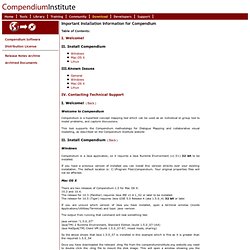
Install Compendium (Back) Compendium is a hypertext concept mapping tool which can be used as an individual or group tool to model problems, and capture discussions. This tool supports the Compendium methodology for Dialogue Mapping and collaborative visual modelling, as described on the Compendium Institute website Compendium is a Java application, so it requires a Java Runtime Environment (v1.5+) 32 bit to be installed. If you have a previous version of installed you can install this version directly over your existing installation. There are two releases of Compendium 1.5 for Mac OS X: 10.3 and 10.4. If you are unsure which version of Java you have installed, open a terminal window (inside Applications/Utilities/Terminal) and type: java -version The output from running that command will look something like:
Compendium (software) Compendium is a computer program and social science tool that facilitates the mapping and management of ideas and arguments.
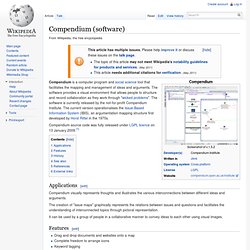
The software provides a visual environment that allows people to structure and record collaboration as they work through "wicked problems". The software is currently released by the not-for-profit Compendium Institute. The current version operationalises the Issue-Based Information System (IBIS), an argumentation mapping structure first developed by Horst Rittel in the 1970s. Compendium source code was fully released under LGPL licence on 13 January 2009.[1] Compendium visually represents thoughts and illustrates the various interconnections between different ideas and arguments. The creation of "issue maps" graphically represents the relations between issues and questions and facilitates the understanding of interconnected topics through pictoral representation.
Many associations have thence contributed ideas to the development of Compendium. Idea Mapping using Compendium. Cmap, le mappe concentuali gratuite in italiano - VirtuaLearn. How to make a concept map. "A good way to define the context for a concept map is to construct a Focus Question, that is a question that clearly specifies the problem or issue the concept map should help to resolve.

Every concept map responds to a focus question, and a good focus question can lead to a much richer concept map"[1] (Cañas and Novak) When you feel you have a focus question that gets to the heart of the subject you intend to map, you will add boxes containing the concepts related to the question. Where you can, add linking phrases showing how the concepts are related, but if you have not decided how they are linked, leave the linking phrase empty or the concepts unattached. Knowledge Integration Map. A Knowledge Integration Map (KIM) is a discipline-specific form of concept map.
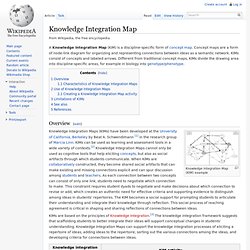
Concept maps are a form of node-link diagram for organizing and representing connections between ideas as a semantic network. KIMs consist of concepts and labeled arrows. Different from traditional concept maps, KIMs divide the drawing area into discipline-specific areas, for example in biology into genotype/phenotype. Overview[edit] Knowledge Integration Map (KIM) example Knowledge Integration Maps (KIMs) have been developed at the University of California, Berkeley by Beat A. KIMs are based on the principles of Knowledge Integration.[3] The knowledge integration framework suggests that scaffolding students to better integrate their ideas will support conceptual changes in students’ understanding. Quadrato semiotico. Da Wikipedia, l'enciclopedia libera.
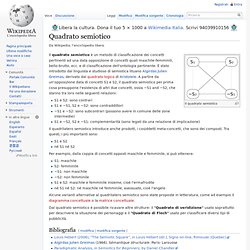
Il quadrato semiotico Il quadrato semiotico è un metodo di classificazione dei concetti pertinenti ad una data opposizione di concetti quali maschile-femminili, bello-brutto, ecc. e di classificazione dell'ontologia pertinente. Cognitivismo - NUOVA DIDATTICA. Joseph D. Novak. Joseph Donald Novak (born 1932) is an American educator, and Professor Emeritus at the Cornell University, and Senior Research Scientist at the Florida Institute for Human & Machine Cognition.

He is known for his development of concept mapping in the 1970s. Biography[edit] Joseph Novak received a B.S. in Science and Mathematics in 1952 from the University of Minnesota, an M.S. in Science Education in 1954 from the University of Minnesota, and completed his graduate studies in Science Education & Biology at the University of Minnesota in 1958. Novak started teaching biology at Kansas State Teachers College at Emporia from 1957 to 1959, and biology and teacher education courses at Purdue University from 1959 to 1967. Concept map. An Electricity Concept Map, an example of a concept map A concept map or conceptual diagram is a diagram that depicts suggested relationships between concepts.[1] It is a graphical tool that designers, engineers, technical writers, and others use to organize and structure knowledge.

A concept map typically represents ideas and information as boxes or circles, which it connects with labeled arrows in a downward-branching hierarchical structure. The relationship between concepts can be articulated in linking phrases such as causes, requires, or contributes to.[2] Overview[edit] A concept map is a way of representing relationships between ideas, images, or words in the same way that a sentence diagram represents the grammar of a sentence, a road map represents the locations of highways and towns, and a circuit diagram represents the workings of an electrical appliance. Concept maps were developed to enhance meaningful learning in the sciences. Differences from other visualizations[edit] The Theory Underlying Concept Maps and How to Construct and Use Them.
Concept maps are graphical tools for organizing and representing knowledge.
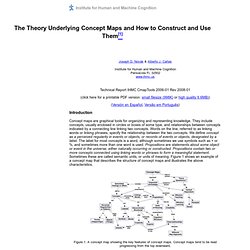
They include concepts, usually enclosed in circles or boxes of some type, and relationships between concepts indicated by a connecting line linking two concepts. Words on the line, referred to as linking words or linking phrases, specify the relationship between the two concepts. Novak, Dr. Andrew D. Novak.